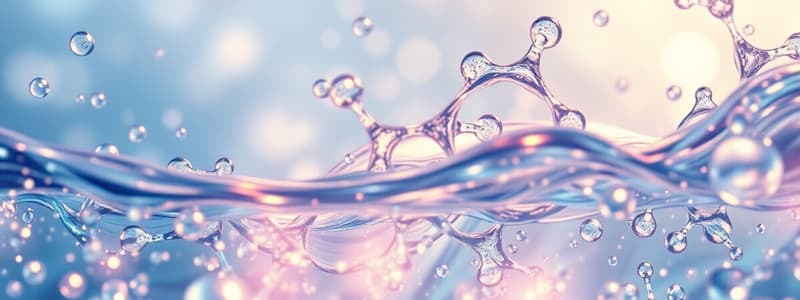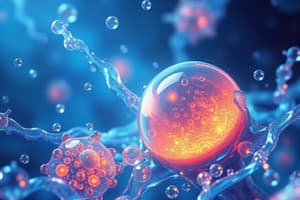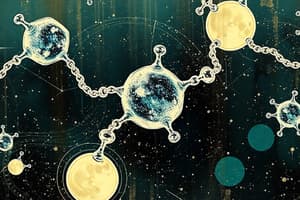Podcast
Questions and Answers
Explain how cohesion and adhesion work together to create capillary action in plants, and why this is important for the plant's survival.
Explain how cohesion and adhesion work together to create capillary action in plants, and why this is important for the plant's survival.
Cohesion is the attraction of water molecules to each other, while adhesion is the attraction of water molecules to other substances. In plants, water molecules use these properties to move up a plant against gravity. The water molecules uses cohesion to stick with each other and adhesion to spread and move upwards.
If a lake is rapidly polluted with a non-polar substance, what property of water is most directly affected, and how might this impact aquatic life?
If a lake is rapidly polluted with a non-polar substance, what property of water is most directly affected, and how might this impact aquatic life?
Water's solvency would be affected, because water can only interact with polar and ionic substances. This will affect how water dissolves molecules in the lake and may kill aquatic life.
Describe a scenario where water's high latent heat of vaporization is essential for regulating temperature in both an organism and its environment.
Describe a scenario where water's high latent heat of vaporization is essential for regulating temperature in both an organism and its environment.
Humans sweat to cool off. As the sweat evaporates, it absorbs heat from the body due to water's high latent heat of vaporization, thus cooling down the body. This process also cools the immediate environment around the person.
Explain why ice floats, and discuss the consequences for aquatic ecosystems if ice were denser than liquid water.
Explain why ice floats, and discuss the consequences for aquatic ecosystems if ice were denser than liquid water.
How does water's high specific heat capacity contribute to the stability of ocean temperatures, and why is this important for marine organisms?
How does water's high specific heat capacity contribute to the stability of ocean temperatures, and why is this important for marine organisms?
Describe how the properties of cohesion and adhesion contribute to the phenomenon of surface tension in water. Provide an example of how surface tension affects small organisms.
Describe how the properties of cohesion and adhesion contribute to the phenomenon of surface tension in water. Provide an example of how surface tension affects small organisms.
Explain how water's solvent properties facilitate the transport of nutrients and waste products within the circulatory system of animals.
Explain how water's solvent properties facilitate the transport of nutrients and waste products within the circulatory system of animals.
How might climate change, specifically rising temperatures, impact water's ability to support life, considering its high latent heat of vaporization and high specific heat capacity?
How might climate change, specifically rising temperatures, impact water's ability to support life, considering its high latent heat of vaporization and high specific heat capacity?
Flashcards
Adhesion
Adhesion
Attraction between different types of molecules.
Cohesion
Cohesion
Attraction between like molecules.
Capillary Action
Capillary Action
Water's ability to move against gravity in small spaces, using cohesion and adhesion.
Density
Density
Signup and view all the flashcards
Solvent
Solvent
Signup and view all the flashcards
Latent Heat of Vaporization
Latent Heat of Vaporization
Signup and view all the flashcards
Specific Heat Capacity
Specific Heat Capacity
Signup and view all the flashcards
Water Density (Solid vs. Liquid)
Water Density (Solid vs. Liquid)
Signup and view all the flashcards
Study Notes
- Adhesion is the attraction between different types of molecules.
- Cohesion is the attraction between like molecules.
- Capillary action allows water to move against gravity in small spaces via cohesion and adhesion.
- Density is the mass of a substance per unit volume.
- A solvent dissolves a solute.
- A solute is dissolved by a solvent.
- Latent heat of vaporization is the energy needed to change a liquid to a gas.
- Water requires lots of energy to turn into a gas due to its high latent heat of vaporization.
- Specific heat capacity is the amount of heat needed to raise a substance's temperature.
- Water needs a lot of energy to increase in temperature because of its high specific heat capacity.
Properties of Water
- Cohesion and Adhesion for capillary action
- High latent heat of vaporization
- High specific heat capacity
- Water is a solvent, dissolving ions and polar molecules.
- Less dense as a solid due to its crystalline structure.
Molecular Interactions of Water
- Water interacts with polar molecules.
- It interacts with ionic compounds.
- It interacts with negatively charged ions.
- Water interacts with positively charged ions.
- Water doesn't interact with non-polar molecules.
- Hydrogen bonding causes water cohesion.
- Water molecules sticking together is cohesion.
- Water molecules sticking to windows is adhesion.
- Water rising against gravity is capillary action.
- Ice floats on water because it is less dense as a solid (crystalline structure).
- Water's solvency is its ability to dissolve molecules.
- Water evaporating at 705 degrees Fahrenheit illustrates high latent heat of vaporization.
- Water needing a lot of energy to raise its temperature indicates high specific heat capacity.
Water's Life-Supporting Properties
- Water as a solvent helps organisms break down molecules.
- Water being less dense as a solid allows marine life to survive under ice in winter.
- Water's high specific heat capacity stabilizes temperature for aquatic life.
- Water's ability to absorb heat keeps waters warmer during winter.
Studying That Suits You
Use AI to generate personalized quizzes and flashcards to suit your learning preferences.




